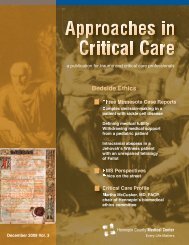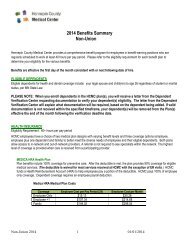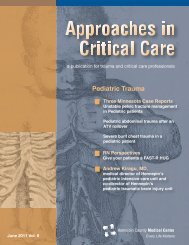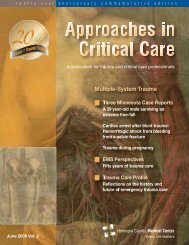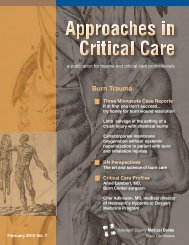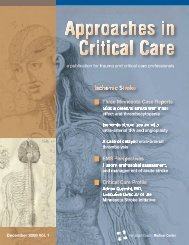HCMC_P_049062 - Hennepin County Medical Center
HCMC_P_049062 - Hennepin County Medical Center
HCMC_P_049062 - Hennepin County Medical Center
You also want an ePaper? Increase the reach of your titles
YUMPU automatically turns print PDFs into web optimized ePapers that Google loves.
Case Reports<br />
Figure Two: Photographs showing bright red discoloration of the patient's skin (A) and urine (B) after treatment with hydroxocobalamin for<br />
cyanide poisoning. Cescon D W , Juurlink D N. CMAJ 2009; 180:251-251. Used with permission.<br />
invaginated scolex is clearly seen inside of the cystic cavity.<br />
1980s and was FDA approved in the US in 2006.<br />
Hydroxocobalamin is given 5g IV and may be<br />
repeated. It rapidly binds and detoxifies circulating<br />
cyanide anions to form cyanocobalamin (vitamin<br />
B12). Adverse reactions are limited to transient<br />
reddening of the skin and bodily fluids (Figure Two),<br />
minor allergy, transient hypertension, and temporary<br />
interference with colorimetric laboratory tests. Since<br />
routine serum HCN levels are lacking, administration<br />
is empiric.<br />
Suspect and treat HCN toxicity in patients with:<br />
1. Suspected smoke inhalation (carbonaceous<br />
sputum, enclosed fire, etc.)<br />
2. Altered mental status<br />
3. Cardiovascular instability (especially systolic<br />
blood pressure < 90mmHg in adults)<br />
4. Initial serum lactate > 8.0mmol/L<br />
Given the rapid mechanism of action of both HCN<br />
and the antidote, there should be no delay in<br />
antidotal treatment of unstable patients without<br />
laboratory values. After administration of<br />
hydroxocobalamin, clinicians may consider treatment<br />
with sodium thiosulfate (STS) through a separate<br />
line. STS in conjunction with endogenous rhodanase<br />
detoxifies HCN to thiocyanate. STS is a constituent<br />
of the older cyanide antidote kit, which also included<br />
amyl, butyl, and sodium nitrite. The nitrites induce<br />
methemoglobinemia and should be avoided in<br />
patients suffering from concomitant CO toxicity.<br />
should now readily identify that her profound<br />
alteration of mental status, inhalational injury, and<br />
high lactate as nearly diagnostic of cyanide toxicity.<br />
Both conditions warrant immediate treatment. Our<br />
patient was fortunate to have received timely<br />
therapies, including emergency department<br />
resuscitation, airway management, hydroxocobalamin,<br />
sodium thiosulfate, and hyperbaric oxygen. Her<br />
ultimate full recovery would not have been possible<br />
without the continued thorough inpatient treatment<br />
from a multidisciplinary care team in the burn unit. <br />
References<br />
Baud, F. J., S. W. Borron, B. Megarbane, H. Trout, F. Lapostolle,<br />
E. Vicaut, M. Debray, and C. Bismuth. Value of Lactic Acidosis in<br />
the Assessment of the Severity of Acute Cyanide Poisoning. Crit<br />
Care Med 30, No. 9. Sep 2002: 2044-50.<br />
Cone, D. C., D. MacMillan, V. Parwani, and C. Van Gelder. Threats<br />
to Life in Residential Structure Fires. Prehosp Emerg Care 12, No.<br />
3. Jul-Sep 2008: 297-301.<br />
Grabowska, T., R. Skowronek, J. Nowicka, and H. Sybirska.<br />
Prevalence of Hydrogen Cyanide and Carboxyhaemoglobin in<br />
Victims of Smoke Inhalation During Enclosed-Space Fires: A<br />
Combined Toxicological Risk. Clin Toxicol (Phila) 50, No. 8. Sep<br />
2012: 759-63.<br />
Nelson, Lewis, and Lewis R. Goldfrank. Goldfrank's Toxicologic<br />
Emergencies. 9th ed. New York: McGraw-Hill <strong>Medical</strong>, 2011.<br />
O'Brien, D. J., D. W. Walsh, C. M. Terriff, and A. H. Hall. Empiric<br />
Management of Cyanide Toxicity Associated with Smoke Inhalation.<br />
[In Eng]. Prehosp Disaster Med 26, No. 5. Oct 2011: 374-82.<br />
Weaver, L. K., R. O. Hopkins, K. J. Chan, S. Churchill, C. G. Elliott,<br />
T. P. Clemmer, J. F. Orme, Jr., F. O. Thomas, and A. H. Morris.<br />
Hyperbaric Oxygen for Acute Carbon Monoxide Poisoning. N Engl<br />
J Med 347, No. 14. Oct 3 2002: 1057-67.<br />
Conclusion<br />
In our patient, the COHb of 41% is consistent with<br />
severe carbon monoxide toxicity; however, clinicians<br />
Approaches in Critical Care | January 2013 | 11




